Components of the Citys Physical Identity: a Review of in Iranian Cities
Aref Agha Safa2 * , Sara Donboli1 and Hossein Kalantari Khalil Abad3
DOI: http://dx.doi.org/10.12944/CWE.12.2.07
Nowadays in countries with long history and civilization most of factors that distinguish the historical city is available in the form of physical identity. It always absorbs significant attention of urban planners, residents and visitors and quality of life. It has played an important role in quality of next generation. The objective of this research is to investigate and analysis the components of the city's physical identity in Iranian cities such as Isfahan, Shiraz and Yazd and capabilities of that historical urban identity in field of natural artifact and human factors. Research method is descriptive-analytical with qualitative and quantities approach to recognize and prioritize the factor using AHP analytical hierarchical process that provides a comprehensive and rational framework for structuring a decision problem, for representing and quantifying the Iranian cities , for relating those elements to physical identities, and for evaluating them. This applied study has a descriptive-analytical basis with a population of 30 experts in urban planning and citizens and local people completed 120 questionnaires. Cultural matters and academic staff used as participants. First, the quality physical identity was determined based on the 3 main criteria and 15 sub-criteria in a hierarchical tree. Then experts were asked to score the major and minor criteria and specify their priorities based on paired comparisons. Applying the Expert Choice, which implements the AHP, the weights of each criterion and sub-criterion were estimated respectively. Finally, according to the Iranian urban identity were described. The results obtained showed that the artifact factor, weighting 0.614, got the first priority and it was followed by natural (0.268), and human (0.117) criteria, which got the second to the third rank.
Copy the following to cite this article:
Donboli S, Safari A. A, Abad H. K. K. Components of the Citys Physical Identity: a Review of in Iranian Cities. Curr World Environ 2017;12(2). DOI:http://dx.doi.org/10.12944/CWE.12.2.07
Copy the following to cite this URL:
Donboli S, Safari A. A, Abad H. K. K. Components of the Citys Physical Identity: a Review of in Iranian Cities. Curr World Environ 2017;12(2). Available from: http://www.cwejournal.org/?p=17355
Download article (pdf)
Citation Manager
Publish History
Select type of program for download
| Endnote EndNote format (Mac & Win) | |
| Reference Manager Ris format (Win only) | |
| Procite Ris format (Win only) | |
| Medlars Format | |
| RefWorks Format RefWorks format (Mac & Win) | |
| BibTex Format BibTex format (Mac & Win) |
Article Publishing History
| Received: | 2017-05-11 |
|---|---|
| Accepted: | 2017-07-18 |
Introduction
In most of period, human settlements are going through progress and revolution. Universal Changes, that appear in all of the world, have most significant impact on the development and formation of cities.1 These progress and revolution have affected several urban problem in political, cultural and economical, and managed to arise of environmental problem. Today urban identity in all aspect of city characteristics 2 depend on the entire history and social characteristics of a city. Changes in the shape of the city must be balanced in the lives of the inhabitants in order to protect the environment.3 Urban identity in most of eastern countries, consists of a series of cultural events in different period with the aim of preserving the past. This identity can be defined as the characteristic difference between these cities from other one.4 An also it has a lively and endlessly changing structure. In all historical stages, each social identity, create in a city has may reflected physical identity of that city.5 Urban identity is such a expressive truth took by a procedure from past to present that effects city shape; it has distinctive scale and stylistic properties in each city; is shaped by physical, cultural, socioeconomic, historical and formational factors; is formed by urban people and their life style; develops continuously and maintains the concept of sustainability.6 Urban identity has been accepted as “the sum of the components in the diagnostic quality which defines a city and distinguishes it from the others”7 Urban identity is defined with the natural and artificial elements and socio-cultural characteristics of a city and the environment. The urban form in the Iranian cities is defined according to the meaning got by its identity format from the content that is affected by the theoretical foundations of the Iranian architecture, art,8 and urbanism, emphasizing that the form-content relationship like the body-spirit relationship is obvious in the worldview foundations.9 This study is an attempt associated with two steps to provide a theoretical framework for reviewing Iranian cities,10 as well as measures to promote urban identity. The main objective of this study is to evaluate the identity of three historical cities in Iran to achieve a theoretical framework for reviewing city's physical identity of urban spaces in Isfahan Shiraz and Yazd.11
Methodology
The issue of city's physical identity in Iranian cities is not a new topic, but, it is an essential tool to create urban identity and physical city planning in Iran.12 In pursuing this aim, the methodology aims to evaluate the urban physical identity according to public opinion. Therefore, in theoretical part, the paper briefly considers the concept of urban identity, in three historical Iranian cities. Then in practical parts: firstly, a questionnaire containing fifteen questions was designed in three parts. The questionnaire developed for the selected domains and indicators of Natural, Artifact and Human factor and prepare for expert and local people,13 and secondly based on a library methods and a review of literature from Iranian cities (flowchart 2). Responding to questions on the form and weight of components and indicators designed to determine the effects of city's physical identity. Validated by experts and professors of the validity and reliability of urban planning and field test has been conducted.14 The study population consisted of all experts and people who have been in contact with these areas. Based on the financial and time constraints of the study, 150 questionnaires were collected. Of these, 30 questionnaires by experts and citizens in the region of 120 questionnaires were completed. To answer questions, choose the common people used simple random sampling and the selection of experts, the first stage cluster sampling, and then each cluster were randomly selected number.15
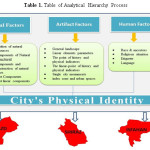 |
|
Case Studies
In this research try to choose cities that played important role in physical identity of Iranian cities such as Isfahan, Yazd and Shiraz city (figure 1)
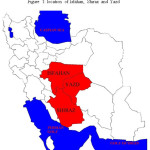 |
|
Isfahan
Isfahan province with an area of ​​about 107,019 square kilometers, allocating 57.7 percent of the country's total area in the center of Iran's plateau. Based on the results of the general census of population and housing, 1390 the population of the province was 4879312 people.16 Esfahan is the third largest city in Iran after Tehran, Mashhad and the third most populous city in Iran after Tehran and Mashhad. Isfahan is also located 435 kilometers from the capital and in the south of the city.17 the city is one of the few valuable archaeological centers in the world and many of its ancient works are listed on the historical list.This city is famous for its beautiful Islamic architecture in many beautiful boulevards, covered bridges, beautiful tunnels, palaces, mosques and unique minarets.
Table 2: Components of Isfahan city identity
|
Components of city identity |
Isfahan |
|
|
Natural factors |
position of natural resources |
Located in a semi-desert area along the river in central Iran, the climate mild and dry |
|
Components of Natural structural |
Zayandeh-roud river |
|
|
Components and construction of natural zones |
Hezar Jerib garden |
|
|
spot Components |
Sofeh and Baba Said Mountain (south of Isfahan),Ghaleh Bozi Mountain (West of Isfahan), Kolahghazy Mountain (Southeast Shahreza), Yaran Kooh Mountains (Southern Shahreza), Nazhvan Forest (zayandehrood) |
|
|
Spot linear components |
Zayandeh-roud river |
|
|
Artifact factors |
General landscape |
Wide streets and large squares, wide gates, mosques and royal palaces, chahar-bagh (four garden) |
|
Linear elements parameters |
Chahar Bagh Axis , the river, the market |
|
|
The point of history and physical indicators |
Kohneh Square,Naghsh-e-Jahan Square |
|
|
The linear-point of history and physical indicators |
Naghsh-e-Jahan Square, Zayandeh-Roud river |
|
|
Single city monuments |
Imam Mosque, Sheikh Lotfollah Mosque, Ali Qapu, the Palace of Eight Paradises of the market, Allahverdi Khan Bridge, bridge Khajoo gheysarie, Bazaar, Karvansaras |
|
|
index zone and urban spaces |
Jolfa and Farah Abad and Abas Abad (Housing Armenians), Lonbon and Qenyan and the Sar peleh (economy), Khajoo and Bagh karan, Karan and Seyyed Ahmadian, Chelman and Sonbolan and scope of Darb-e Imam, Dardasht (economic, political and military), Judea. |
|
|
Human factors |
Race & ancestors |
Ayaran and Armenians |
|
Religious situation |
Shias thought mastered the city, Islamic values, especially the values and principles derived from the Safavid that represent themselves more. |
|
|
Etiquette |
Social and cultural life of people with common intersection of Safavid art era, art and business activities, sounds and smells of the city market activity (voice woodcarving, copper casting and ... and sweet smell in the bazaar) |
|
|
Language |
persian, Isfahan dialect |
|
Shiraz
One of the major cities in Iran and the capital of Fars province. Based on the latest census of the Iranian Center for Statistics in 2006, the city has a population of 1, 214, 808, which has increased to 1,455, 073 in 2009.The original site of this city was at the castle of Abu Nasr. The city of Shiraz was a fortress before Islam, dating back to the Sassanid era. The city is being transferred to the current site during the Bani-omayeh period, and it thrives at the expense of the collapse of the old capital of the Fars province. Shiraz was the capital of Iran during the Safaryan, Boeyan and Zandieh periods. Due to its many historical, cultural, religious and natural attractions, it has always attracted many tourists.18
Table 3: Components of Shiraz city identity
|
Components of city identity |
Shiraz |
|
|
Natural Factors |
position of natural resources |
Located in the Zagros Mountains, with a mild climate, warm and dry |
|
Components of Natural structural |
Khosk river(dry river) |
|
|
Components and construction of natural zones |
Ghasroldasht gardens in the North and North West of Shiraz, Orangery garden |
|
|
spot Components |
Bamou Highlands (north of Shiraz), Mountain Drake (West Shiraz), mountains of Ghebleh (Mecca) and Sabzpushan (southwest and south of Shiraz), mountain Maharloo (East Shiraz) |
|
|
Spot linear components |
Aqueduct azodi ,Khosk river(dry river) |
|
|
Artifact Factors |
General landscape |
Streets with grid iron pattern (organic), visiting Shiraz between the mountains in the middle of the colorful domes. the fence and the fort of the city and the beautiful cypress trees in their gardens around town to show off the Quran Gate |
|
Linear elements parameters |
Khosk river(dry river)Shiraz, Bamou, Drack, Sabzpushan and Maharloo heights |
|
|
The point of history and physical indicators |
Toopkhaneh Square,Mashgh Square, Hosseinieh Haft tanan, Hosseinieh chehel tanan, school Khan, Atiq Mosque, the New Mosque Atabak, Vakil Mosque |
|
|
The linear-point of history and physical indicators |
Toopkhaneh Square, ,Mashgh Square, Karimkhani buildings, Ali ibn Hamzah, Shahcheragh, Seyed Alaeddin Hussein domes |
|
|
Single city monuments |
Monuments: the tomb of Hafez, Khajoo, Saadi, Sheikh Kabir, Sheikh Roozbahan, Shah Shuja, Sibooyeh, Quran Gate Church of Simeon, the monastery Ahmadi, Adrian (Zoroastrian temple) Shahcheragh monument, the threshold Seyed Alaeddin Hussein, the tomb of King motive to Allah , Shah Mir Hamzeh shrine, the tomb of Sheikh Mohammed Lahiji, New Mosque, the Old Mosque, the Pars Museum, Khan school, Eram garden, garden beds, garden delights, … |
|
|
index zone and urban spaces |
Heidari home neighborhoods: the neighborhood Ishagh Beyg, the poultry market neighborhood, the neighborhood Bala Kaf, neighborhood doors prince, King Square neighborhood B: gift neighborhoods, neighborhoods of the garden, Head Quarters (Dezzak Castel), Black Rock neighborhood, neighborhood water's edge, a new door of the mosque neighborhood, neighborhood Jewish |
|
|
Human Factors |
Race & ancestors |
Persian people |
|
Religious situation |
Almost Muslim |
|
|
Etiquette |
Social and cultural life, art activities and business people, the smell of orange blossom in the city |
|
|
Language |
Persian ,dialect Shirazi |
|
Yazd
Yazd province with a total area of ​​74493 square kilometers is the fourth largest province of the country, located in the central part of the Iranian plateau in the margin of the plains of the Lut River. The waves are 29 degrees and 52 minutes to 33 degrees and 27 minutes north and 52 degrees 55 minutes to 56 degrees 37 minutes. East is located.
Yazd province has 10 cities (Yazd, Abarkouh, Ardakan, Bafgh, Taft, Khatam, Sadouq, Mehriz and Meybod), 23 cities, 20 districts and 51 villages with Semnan provinces northwest, Isfahan from west, Fars from southwest, Khorasan South of east, Khorasan Razavi from north east and Kremans from east and south east of neighboring.Water reservoirs, wind farms, refiners and mills are the characteristics of this province.19 Historic city of Yazd, as the first historic city of Iran and the twenty-first historical monument of the country, was registered on the UNESCO World Heritage List.
Table 4: Components of Yazd city identity
|
Components of city identity |
Yazd |
|
|
Natural factors |
position of natural resources |
Located in central Iran Shirkooh between mountain ranges, has a warm and dry desert climate |
|
Components of Natural structural |
Yazd is located in the valley between the mountains Yazd is located in the valley between the mountains Shirkooh |
|
|
Components and construction of natural zones |
desert |
|
|
spot Components |
Desert and Shirkooh height |
|
|
Spot linear components |
Aqueducts, refrigerator, water storages |
|
|
Artifact factors |
General landscape |
Dowlat Abad Garden, cypress trees emerged from the central courtyard houses, narrow streets with relatively high walls and along a line break, two perpendicular axes (Imam streets and resurrection) to comply with the organic tissue City |
|
Linear elements parameters |
Lack of edge because of interruption in the continuity of texture density and texture structures of residential and nonexistence of large gaps or spaces inside |
|
|
The point of history and physical indicators |
Hosseinieh, mosque, community centers and squares |
|
|
The linear-point of history and physical indicators |
Amir Chakhmaq squares, Maidan Shah Tahmasp, mosque, Amir flint and comprehensive |
|
|
Single city monuments |
Hosseinieh, Mosque, mosque, Amir Chakhmaq, City Market, cisterns, wind towers, gardens |
|
|
index zone and urban spaces |
Neighborhood: Amir Chakhmaq, new Kooshk, four minarets, Abshahy, Abualmaly and |
|
|
Human factors |
Race & ancestors |
People of Iran |
|
Religious situation |
Almost Muslim and Zoroastrian |
|
|
Etiquette |
Artistic and commercial activities people (goldsmith industry, carpet industry, textile industry), the sounds and smells of the city market activity (coppersmith sound and smell of sweets in bazaar) |
|
|
Language |
Persian ,dialect Yazdi |
|
Analytical Hierarchy Process (AHP)
The Analytical Hierarchy Process (AHP) is one of the most popular multi-purpose decision-making techniques, first developed by Thomas L. An Iraqi hour was devised in the 1970s. The hierarchical analysis process reflects the natural behavior and human thinking. This technique examines complex issues based on their interactions, and turns them into a simple way to solve them. A hierarchical analysis process can be used when decision-making practice is faced with multiple competing choices and decision criteria.20 The proposed criteria can be quantitative and qualitative. The basis of this method lies in the decision of the paired comparison. The decision maker starts with the process of bringing the hierarchical tree to the decision. The tree of the decision hierarchy, the compared factors, and the competing choices being evaluated in the decision. Then a series of pairwise comparisons is performed. These comparisons show the weight of each of the factors in line with the competing choices being evaluated in the decision. Finally, the logic of the hierarchical analysis process combines the matrices derived from the paired comparisons to arrive at an optimal decision (Table 5). The Principles of Analytic Hierarchy Process Thomas A. Sachet (the founder of this method) expresses the following four principles as the principles of the hierarchical analysis process and has based all the calculations, laws and regulations on these principles. The hierarchical analysis process model involves the following four main steps:
2. Preferred Judgment (Paired Comparisons):Perform comparisons between different decision options, based on each indicator (table 5)
3. Relative weights calculations:Determine the weight of "decision elements" relative to each other through a set of numerical calculations
4. Integration of relative weights in order to rank decision choices: At this stage, we must multiply the relative weights of each element in the weight of the higher elements in order to obtain the final weight. By doing this for each option, the amount of final weight is obtained.
Table 5: Preference values ​​for paired comparisons
|
Numerical value |
Preferences (Oral Judgment) |
|
1 |
Preference, the same importance or utility |
|
3 |
A little reference, more or less desirable |
|
5 |
Prefer or strong |
|
7 |
Preference or very strong significance |
|
9 |
Quite a reference, quite desirable |
|
2,4,6,8 |
Preferences between the above intervals |
Sources:(David, 1963)[21]
Results and Discussion
Components related to physical identity 22 has been shown in table (1, 2, and 3). In the first level, the research objectives should be addressed. (prioritizing the Iranian physical identity in order to Components of case studies), in the second level Comparisons the elements of these cases by experts and performed using paired comparison and the third level, the prepare the diagram for compare the physical identity which is shown on the basis of the main criteria of the research. (Figure 2)
The weights obtained for each of the three main components are shown in Table 6. Based on this information, artifact factors with a weight of 0.614, natural factors with a weight of 0.268, human factors with the highest of 0.117 have gained. In this calculation, the Inconsistency rate is 0.07, which is less than 0.1, indicating the parallelism between the pairwise comparisons.
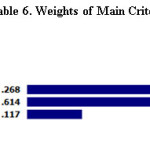 |
|
The weight of the natural components is shown in Table 7. Based on the information obtained, the location of natural resources, the components of the natural structure of the region are highest in the order of magnitude. In addition, the level of inconsistency is 0.0224, which is less than 0.10, indicating that compatibility between pair comparisons is very high.
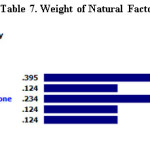 |
|
Table 8 shows the weights obtained for the economic factor. According to the information obtained, General land scape , the point of history and physical indicators and single city monuments rate have the highest weights, respectively.
The Inconsistency is 0.02, which reflects the compatibility between the pair comparisons.23
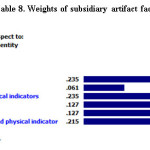 |
|
The weight for each subset is shown in Table 9. According to information obtained, etiquette, language, race, and ancestors have the highest rates. The Inconsistency rate is 0.01, which is less than 0.1 and represents a correlation between pairwise comparisons
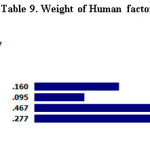 |
|
Performance sensitivity and dynamic sensitivity of Iranian city’s physical identity with main criteria (Isfahan, Shiraz and Yazd) have been presented in table 10 . based on the obtained results, Isfahan with 44.1% got the highest rate, shiraz with 29.9 and Yazd with 25.9 stand in the next levels. The results obtained from the expert opinions regarding the indicators of urban physical identity tested under sensitivity analysis using Expert Choice software have been shown in Table 10.as per as the result artifact factor with 61.4% has the highest sensitivity.
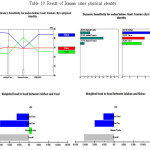 |
|
The statistical graphs and diagrams that shows in figure 10 represent the evaluation and comparison of the two components and sub-components and the alternatives relative to each other. The vertical axis represents the final weight of the criterion, and the horizontal axis represents the main criteria. The human, artificial and natural factors of all three dimensions were measured. In the final figure shows the paired comparison between the Iranian cities.
Table 11: Result base on study
|
Political influence on the identity of the city |
Cultural influences on the city's identity |
Economic impact on the city's identity |
The effect of climate on the identity of the city |
Final result |
|
|
Isfahan |
King was built Naqsh-e Jahan Square, stand on the porch o ali-ghapoo, and shows his power to people. The political aspect is reinforced. |
The formation of linear elements such as Chahar, and Naqsh-e Jahan Square all indicators focal point of political influence.It passed with his buggy in chaharbagh street and go to the gardens and people on both sides to stand and watch her power. |
Isfahan bazaar that is connecting Mydan-kohneh and Naqsh-e-jahan |
Large area buildings, indoor and outdoor, clay brick and original materials. |
Politics has the effects on identities |
|
Shiraz |
Construction of mashgh squares and toopkhaneh and other buildings around it and dominate the organ |
The most massive and the most eternal of history and civilization of Iran is in the fars province. Celebrities, literature, philosophy and science was in the shiraz city .Cultural and historical monuments in Fars and Shiraz, was not just put a period to the modern century in all periods of history of the Achaemenid the most important parts of Iran and the entire region. |
the city has long due to its relative centrality in South Zagros region and located in a relatively fertile area,it was the natural local products to local exchanges between farmers and nomads |
Clay brick and stone is the main construction materials that are derived from regional climate |
Culture affects identity |
|
Yazd |
Daralkhalafeh has been created in different periods and in the Daralhokumeh is the seat of the governor. |
Religious city, Hosseinieh, Takaya, honesty and integrity |
Yazd bazaar |
Organic architecture, influenced by the City of climate (bricks and mud), interconnected buildings, arched and domed arches, thick walls, compact urban texture , residential introverted types, wind towers, cistern, streets with awnings, awning. |
Climate affects identity. |
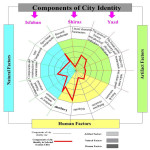 |
|
Conclusion
Urban identity is not known only as physical, Artifact and Human factors , but it is a mental ,Political, and Cultural element that its formation in people’s mind has direct relevance with the interventions of climate, Economic and historical beliefs.
In Isfahan city, the King was built Naqsh-e Jahan Square, stand on the porch o ali-ghapoo, and shows his power to people. The political aspect is reinforced.and we consequences that Political influence has more effect on the identity of Isfahan city .
shiraz city has The most massive and the most eternal of history and civilization of Iran. . Celebrities, literature, philosophy and science was in the shiraz city .Cultural and historical monuments in Fars and Shiraz, was not just put a period to the modern century in all periods of history of the Achaemenid the most important parts of Iran and the entire region. And we consequences that Culture affects identity has more effect on the identity of shiraz city.
yazd with Organic architecture, influenced by the City of climate (bricks and mud), interconnected buildings, arched and domed arches, thick walls, compact urban texture , residential introverted types, wind towers, cistern, streets with awnings, awning stand on first climate and vernacular architecture level. and we consequences that Climate affects identity has more effect on the identity of yazd city .
Consequently, urban physical identity is one of the main aspect of the city development. The historical value of the city is the backbone of this identity and, they mostly from the first civilizations in the city, their character is emphasized in compromise the urban physical identity. The urban identity of Iran is an image that reflects human relationships with its environment from past to present time. It has a physical, Artifact and Human factors. This also depends on the popular culture, history and images of the human being, Heritage area , relationships, And the strains combined with this combination make the urban disasters understandable in the city and may be full of events, tangible and intangible urban identity.
Acknowledgements
The authors of this paper would like to show appreciation of Acecr-Academic Center for Education, Culture and Research for their assistance to access their record regarding to physical identity for Iranian cities. We also thank the anonymous reviewers for their precious comments and recommendations.
References
- Held, D., McGrew, A., Goldblatt, D., & Perraton, J. (2000). Global transformations: Politics, economics and culture Politics at the Edge (pp. 14-28): Springer.
- Moghimi, L., & Assari, A. (2016). Redefinition of Pedestrian Route-Finding Networks as a Tool to Return Vitality and Responsiveness to Yazd Khan Plaza. Current World Environment, 11(2), 378-387.
CrossRef - Healey, P. (2004). The treatment of space and place in the new strategic spatial planning in Europe. International journal of urban and regional research, 28(1), 45-67.
CrossRef - Assari, A., Mahesh, T., & Assari, E. (2012a). Conservation of historic urban core in traditional Islamic culture: case study of Isfahan city. Indian Journal of Science and Technology, 5(1), 1970-1976.
- Ahn, M., Aliu, E., Andringa, S., Aoki, S., Aoyama, Y., Argyriades, J., . . . Berns, H. (2006). Measurement of neutrino oscillation by the K2K experiment. Physical Review D, 74(7), 072003.
CrossRef - Assari, A., & Assari, E. (2012). Urban spirit and heritage conservation problems: case study Isfahan city in Iran. Journal of American Science, 8(1), 202-109.
- Beyhan, Åž. G., & Gürkan, Ü. Ç. (2015). Analyzing The Relationship Between Urban Identity And Urban Transformation Implementations In Historical Process: The Case of Isparta. International Journal of Architectural Research: ArchNet-IJAR, 9(1), 158-180.
- Sharifi, A., & Murayama, A. (2013). Changes in the traditional urban form and the social sustainability of contemporary cities: A case study of Iranian cities. Habitat International, 38, 126-134.
CrossRef - Pazhuhan, M., Zayyari, K., Ghasemzadeh, B., & Qurbani, H. (2015). Urban Identity and Iranian New Towns. Journal of Urban and Regional Analysis, 7(1), 83.
- Assari, A., & Mahesh, T. (2011b). Urbanization Process in Iranian Cities. Asian Journal of Development Matters, 5(1), 151-154.
- Assari, A., Mahesh, T., Emtehani, M., & Assari, E. (2011). Comparative sustainability of bazaar in Iranian traditional cities: Case studies in Isfahan and Tabriz. International Journal on Technical and Physical Problems of Engineering (IJTPE)(9), 18-24.
- Nasri, A., Beheshty, A. B., & Rahmani, A. (2016). Iranian-Islamic Culture at Making Urban Spaces in Iran. Env. Pharmacol. Life Sci.[Spl. Issue 1], 31, 35.
- Assari, A., Mahesh, T., & Assari, E. (2012b). Role of public participation in sustainability of historical city: usage of TOPSIS method. Indian Journal of Science and Technology, 5(3), 2289-2294.
- Assari, A., Maheh, T. M., & Assari, E. (2015). INVESTIGATING SUSTAINABILITY OF BAZAARS INIRANIAN HISTORICAL CITIES. Paper presented at the The Protection of Archaeological Heritage in Times of Economic Crisis.
- Izadi, M., & Mohammadi, J. (2016). Investigating factors affecting the quality of local cultural spaces applying the AHP technique. دانشگاه علم و صنعت ایران, 26(1), 71-81.
- Assari, A., Maghreby, S., & Nik, M. M. (2017). Investigation of smart growth in traditional Islamic culture: Case study of Isfahan city in Iran. Journal of Geography and Regional Planning, 10(4), 47-56.
- Assari, A., & Mahesh, T. (2011a). Demographic comparative in heritage texture of Isfahan city. Journal of Geography and Regional Planning, 4(8), 463.
CrossRef - Amini, E., Sedghi, N., Eslamlou, M. S., Gorjinia, A., & Ghasemi, T. (2016). The process of globalization, and its impact on the physical form of Islamic cities, with an emphasis on Iran. Bulletin de la Société Royale des Sciences de Liège, 85, 1601-1613.
- Mohammadpur, A., & Mahmoodi, K. (2016). Lifestyle and identity in contemporary Iranian Kurdistan (a grounded study of Marivan City). Quality & Quantity, 50(5), 1907-1928.
CrossRef - Jourshar, S. R., & Kalantari, N. N. (2015). Structural Principles and Frameworks of Iranian-Islamic Urbanization by Reviewing its Formation in Different Periods. evolution, 1(1).
- David, H. A. (1963). The method of paired comparisons (Vol. 12): DTIC Document.
- Arefian, F. F., & Moeini, S. H. I. (2016). Urban Change in Iran: Springer.
CrossRef - Maleki, S., Akhavan, M., & Nafti, M. (2016). Reconciling a City with its Natural Identity (The Role of Water Systems in Mashhad City Sustainable Planning). Procedia Environmental Sciences, 34, 559-572.
CrossRef






